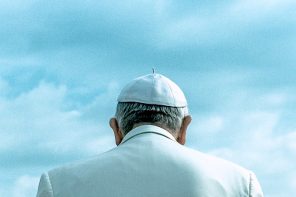In the wake of Pope Francis’ election, much ado has been made about his choice of name. Given that his namesake—Francis of Assisi—has been (since the late 1970s) the “patron saint of ecology,” this would seem to be good news for a world that’s slowly burying itself beneath its own petroleum-derived waste products. In a recent Washington Post Op-Ed, Christiana Z. Peppard suggests that Pope Francis may bring a “pro-creation” politics into the core of the Church, expanding what it means to fight for a “right to life.”
I applaud the pope in any effort he makes to keep water clean, to keep the earth inhabitable. Yes, I think it definitely matters if the pope calls for Catholics to practice a “pro-creation” politics. Please don’t get me wrong. But Peppard’s choice of the phrase “right to life” is ill-considered.
“Right to life” carries a lot of political baggage and, for generations (at least) will evoke anxiety about religion’s institutional management of human sexuality. It’s a contingent, historically determined phrase. It seems, to me, anachronistic to drag it kicking and screaming into a potentially paradigmatic shift.
But this wasn’t the only anachronism in Peppard’s piece. And it got me thinking about how crucial it is to keep historical particularities in mind when we’re thinking about ecological politics—even the ecological politics of saints.
The moment we’re living in, living through, living into, is so radically different from Francis of Assisi’s medieval European moment. We’re surrounded by technology that Francis couldn’t have imagined. We face ethical and political puzzles that would have been unthinkably complex for him.
It seems necessary, to me, to recognize this great distance between his time and ours. Perhaps, above all, to understand that the particular shape of Francis’ ethical practices were conditioned by his own life and times—there may be aspects of them that we don’t want to blindly reiterate.
Peppard remarks, for instance, that Saint Francis is, “in the parlance of our times” basically “a tree hugger.” In fact, he wasn’t. The term “tree hugger” is also a historically particular term. It refers to a form of nonviolent resistance that some humans have practiced in order to prevent the razing of trees through the use of machine technology. The history of the term is entangled with the 1970s Chipko movement, in the Himalayas, when groups of local women claimed their forest rights against the corporate exploitation of the trees that surrounded them.
This kind of political action is unimaginable in the pre-industrial world that Francis occupied—and the type of ecological destruction that occurs in our world today would also likely have been incomprehensible to Francis. The human-tree political solidarity that women in the Chipko movement expressed was—in subtle ways—categorically different from the political solidarities we see in the stories that surround the life of Saint Francis.
Let’s take the story of Francis and the Wolf of Gubbio, for instance. In this tale, Francis appears in the Italian town of Gubbio to problem-solve an ecological dilemma. There’s a wolf on the outskirts of the city who has been sneaking into the city limits at night and stealing livestock—and has begun to prey on people. The locals are terrified and go after the wolf with the meager weapons they have, but the animal attacks and devours anyone who comes after him. This wolf is a force of nature, beyond human control.
This is where Francis comes in. He goes out and meets the wolf, face to face. Francis preaches a little gospel to him, and brings him under the morality of the cross. The wolf bows in his service: domesticated. The world, for Francis’ human kin, becomes a little less terrifying.
I should probably note, at this point, that one can only give so much historical credence to a hagiography. This is meant to be a miracle tale: one beyond belief. I’m not going to trouble this story for historical veracity. But what I want to emphasize is the particular approach that Francis takes. “Tree huggers” and the women of the Chipko movement protected trees and their denizens from the powers of human technology. Here, the people of Gubbio have already used all available technological means and they are still unable to control the natural world.
Francis’ solidarity with both humans and wolf brings about a kind of human-animal political harmony. But, as David Salter points out in Holy and Noble Beasts, Francis’ particular method is taming, or domestication. He is not protecting the wolf from the ravages of human technology so much as he is intervening after other technologies have failed. In the wake of this failure, Francis brings the wolf into the fold of the human community. He humanizes it.
Today we are a great distance from the ecological situation of medieval Italy. With the aid of capital and industry, we humans have become so practiced, and coldly efficient, in matters of animal domestication that we now have health insurance on offer for wealthy domestic pets while billions of other creatures in our care are heedlessly slaughtered. Our domestication practices are a disaster. Domestication as an approach to interspecies conflict does not seem like the most valuable lesson to learn from Francis. A wolf at the outskirts of a human community in the contemporary U.S. would not be met with a leash and a bowl. Francis wasn’t quite a “tree hugger,” nor was his particular approach to human-animal relations one that we might seek to revisit today.
But this doesn’t prevent us from reading Francis as a figure who challenged the shape of political life in his time—and might still, in our own. The world he cared about was bigger, broader, and more complex than that encompassed by human society.
It’s not that we don’t need wisdom or counsel of figures like Francis, but the terrors and trials we face today are unprecedented. No model from the deep past is going to show us, with precision, how to live rightly in this peculiar world that unfolds before us now.




